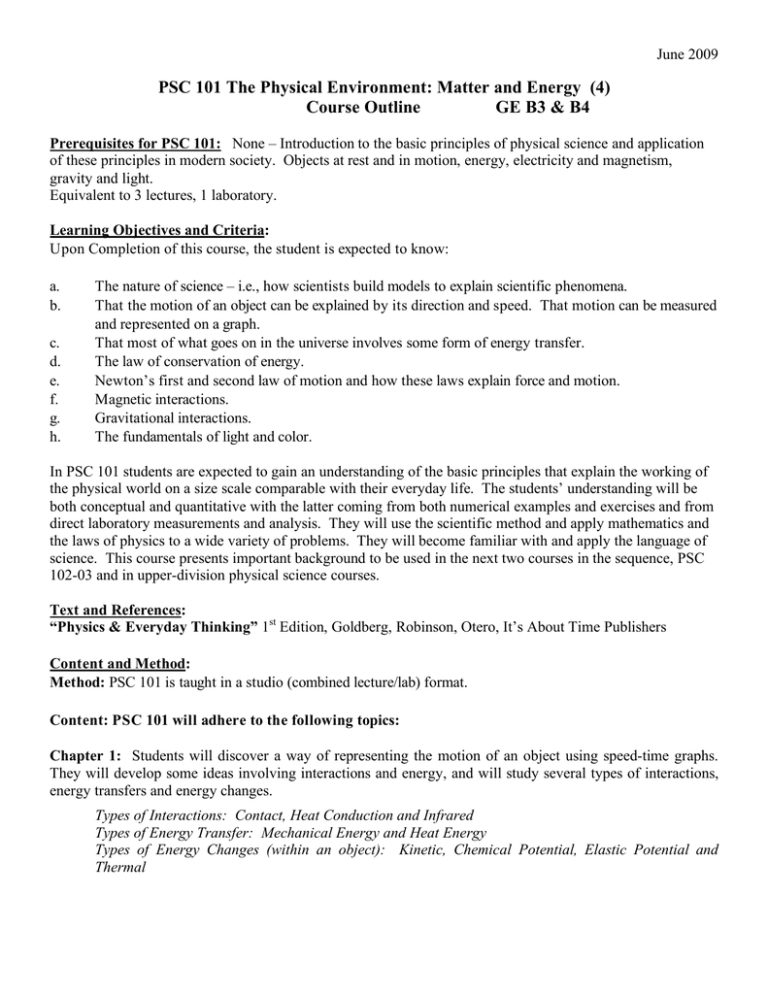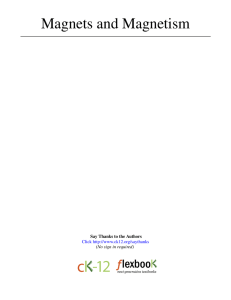PSC 101 - Physical Env
advertisement

June 2009 PSC 101 The Physical Environment: Matter and Energy (4) Course Outline GE B3 & B4 Prerequisites for PSC 101: None – Introduction to the basic principles of physical science and application of these principles in modern society. Objects at rest and in motion, energy, electricity and magnetism, gravity and light. Equivalent to 3 lectures, 1 laboratory. Learning Objectives and Criteria: Upon Completion of this course, the student is expected to know: a. b. c. d. e. f. g. h. The nature of science – i.e., how scientists build models to explain scientific phenomena. That the motion of an object can be explained by its direction and speed. That motion can be measured and represented on a graph. That most of what goes on in the universe involves some form of energy transfer. The law of conservation of energy. Newton’s first and second law of motion and how these laws explain force and motion. Magnetic interactions. Gravitational interactions. The fundamentals of light and color. In PSC 101 students are expected to gain an understanding of the basic principles that explain the working of the physical world on a size scale comparable with their everyday life. The students’ understanding will be both conceptual and quantitative with the latter coming from both numerical examples and exercises and from direct laboratory measurements and analysis. They will use the scientific method and apply mathematics and the laws of physics to a wide variety of problems. They will become familiar with and apply the language of science. This course presents important background to be used in the next two courses in the sequence, PSC 102-03 and in upper-division physical science courses. Text and References: “Physics & Everyday Thinking” 1st Edition, Goldberg, Robinson, Otero, It’s About Time Publishers Content and Method: Method: PSC 101 is taught in a studio (combined lecture/lab) format. Content: PSC 101 will adhere to the following topics: Chapter 1: Students will discover a way of representing the motion of an object using speed-time graphs. They will develop some ideas involving interactions and energy, and will study several types of interactions, energy transfers and energy changes. Types of Interactions: Contact, Heat Conduction and Infrared Types of Energy Transfer: Mechanical Energy and Heat Energy Types of Energy Changes (within an object): Kinetic, Chemical Potential, Elastic Potential and Thermal June 2009 Chapter 2: Newton’s Laws of Motion 1st LAW: If no forces (or a combination of forces that is balanced) act on an object then, if it is at rest, it will remain at rest, and if it is in motion, it will continue to move in a straight line path at a constant speed. 2nd LAW: If a single force (or a combination of forces that is unbalanced) acts on an object, its speed and/or its direction will change. How quickly the speed (and/or direction) changes is directly related to the strength of the net force and inversely related to the object’s mass. Chapter 3: Students will develop scientific models to describe three different ‘action-at-a-distance’ interactions (magnetism, electrostatics and gravity) in which the objects involved exert forces on each other without touching. They will also see how a group of interacting objects could be considered as a ‘system’ and how applying the idea of energy conservation developed in Chapter 1 allowed them to deduce that there were changes in different forms of potential energy within such systems. Chapter 4: Development of the correct model of magnetism through experimentation and discussion: Each magnet has two ends, or poles. Two magnets with like poles facing each other will repel each other. Two magnets with opposite poles facing each other will attract each other. When a magnet is allowed to rotate freely, without any other magnets nearby, the end pointing (approximately) towards the geographical North Pole of the earth is defined as the north pole of the magnet. The opposite end of the magnet is defined as its south pole. • A magnet will always attract a nearby ferromagnetic object. Ferromagnetic objects include iron, nickel and cobalt. Other metals, as well as non-metals, will not interact with a magnet. • Inside a ferromagnetic object there are tiny entities, called magnetic domains. Each magnetic domain behaves like a tiny magnet, with North and South Poles, and cannot be cut up. When drawing domains inside ferromagnetic objects, it is common to use either small bar magnets or arrows. When using an arrow, the head of the arrow represents the North Pole of the domain. Chapter 5: Development of scientific models to describe light, vision and color: • A light interaction occurs when a source of light illuminates an object. • Light travels in straight lines. • When you look at a light source, light interacts with (enters) your eye. • When light interacts with a shiny object, the light is reflected in a particular direction. • When light interacts with a white, non-shiny object, the light is reflected in all directions away from its surface. • When light travels from air into a transparent solid or liquid, or from a transparent solid or liquid into air, the light changes direction. • When light interacts with a pure black object, all the light is absorbed in the object and none is reflected. • Our eye-brain system perceives different energies of visible light entering our eye as different colors. June 2009 Methods of Assessment: Students’ grades are based on homework, journal prompts, quizzes, midterms and the final exam. Exams will consist of problems where the students will use the scientific models they have developed in class to explain real life phenomena. Because of the nature of this curriculum (inquiry-based), attendance is critical to student success.



